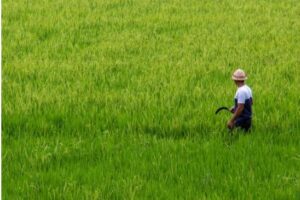
Improvisation is a term that may apply to all, or at least most, activities in life; but I became most aware of its meaning in the context of music, specifically jazz. My father led a jazz quintet in the 1940s and my brother was a successful jazz pianist, having become a musical prodigy at an early age.
While I never had his training in music, owing to the changing conditions of growing up in a family struggling to pay the bills — which meant that my father often worked on construction jobs in other towns, and consequently did not spend the time and resources on myself and my other siblings that he had devoted to training my brother to play the piano — I came to understand that, as far as the ideals of jazz are concerned, improvisation was the holy grail, much more highly valued than the ability to play by rote, or even to read notation. The idea that whatever one can hear — musically speaking, and in one’s mind — should come out through the instrument unimpeded, was what was meant by the expression “playing.” As in “He is playing his (derriere) off,” as my brother-in-law, a trumpet player, would often say of my brother. It is one of the highest compliments in jazz circles.
So I was exposed to this idea at an early age, probably when I was in high school. I had taught myself to draw around the second or third grade, probably to garner attention in a category other than music, as that option was clearly already taken. And my sisters were the dancers in the brood. At the time, I didn’t think of my drawing as improvisation, though I quickly graduated from copying Walt Disney characters to making up my own, developing a comic strip featuring our pet dog, “Squeaky,” a fox terrier to whom I was very attached. But later on, I recognized that what I found interesting about art, performance or plastic, was definitely in the area of improvisation.
I never saw much of a point in repeating the same theme or idea, but more vitality in looking for what else the medium might reveal. This approach I am continuing to explore, all these many years later, in my art. To the degree that I think what I do cannot really be called “painting,” as that term implies the more traditional uses of the medium, with such tools as brushes or a painting knife (small spatula). And it’s not the “drip” painting made famous by Jackson Pollack, considered a major breakthrough at the time.
Instead, my approach may better be referred to as “imaging,” or “rendering” — achieving images using the natural attributes of the pigment, water, and gravity, and the ordinary processes of fluidity and drying to achieve the final result, with as little interference as possible. In other words, witnessing the four elements — earth, wind, fire and water — at play. Freed from human intent, they tend to reveal all the fundamental forms found in nature. In a way, this constitutes a form of improvisation, though strictly adhering to the laws of physics.
I think it important to consider this idea of improvisation in the larger context of life, and in particular that of our Zen practice. When you think of creativity in general, whether at work, at play, or at home — and perhaps especially in terms of relationships — the idea that we might learn to improvise takes on a deeper and broader meaning. Most people, if pressed, would probably admit that they do not regard themselves as very creative, certainly not in the way they make their living, perhaps even less so in dealing with the drudgery of everyday life. But this, I think, is precisely what Zen requires, or suggests, that we should do.
Such expressions as “When tired, I sleep; when hungry, I eat” point at this idea, when considered from the perspective of a fully enlightened being. This old Master is not simply saying that we should just eat when hungry, sleep when tired; he is implying that in this everyday, ordinary and necessary activity is where and how we will find what is missing in our lives, the ultimate, embedded reward, or happiness. Of course, we all sleep when we are tired and eat when we are hungry. But it does not make us happy.
If we are sleeping because we have to — we have to get up early and go to work — then we are not doing so voluntarily, but feel impelled to do so. If we eat when we are hungry simply to “refuel,” as some of my colleagues at work used to refer to a working lunch, then we are never really eating, but preparing for the next task in the endless cue line of corporate issues or problems that we have to deal with to earn our paycheck.
In this context, improvisation may consist of bringing a brown bag lunch to the office so that we can continue working while we are eating. Or we read the newspaper over a solitary lunch, escaping the rat race for a brief respite. This kind of improvisation becomes a “guilty pleasure,” and indulgence we resort to, in order to counter the crushing boredom and stress of “working” — meaning doing something we would rather not be doing — for the sake of livelihood.
Real improvisation in this context could go one of several ways. Either we could find a way to change our livelihood to something that is truly engaging and rewarding on a personal level, or we could find a fresh approach to our current occupation or vocation in the present moment, no matter the external conditions of our employment, or other circumstances we find less than ideal. Such as maintaining a home or an automobile that insists on falling apart from the inexorable strain of age and wear and tear. Or the same dreary progress applied to our own body.
How can we be creative in all dimensions of life, and practice happiness regardless of the specific circumstances? This may sound like the height of irresponsibility, that the only way to be happy in spite of the vicissitudes of human life and the vagaries of nature, means that we have to ignore them, essentially, and continue plowing though, leaving all consequences, intended or not, in our wake. Devil take the hindmost, and all that. Zen is nothing if not responsible, but perhaps the responsibility is to a higher ideal than merely living conscientiously.
But what if we could turn it around, take the backward step, and begin to see that each day, what appears to be the same set of challenges is not — basically cannot possibly be — the same? What if we come to see that this sameness is in the eye of the beholder, and begin to look for, and see, the difference, instead? Or to see the two as complementary? In the ancient Chinese Zen poem, Sandokai, variously translated as some version of Harmony of Sameness and Difference, the great Ancestor reminds us that this great truth goes to the heart of the matter in Zen. The duality that we see in our life, and its negative consequences for us, is all in our mind, namely that self-same monkey mind that we tend to denigrate in Buddhism.
But remember the fundamental function of the monkey mind is to protect our biological survival. We absolutely need to see, hear, and feel both sameness and difference, and to recognize when any change in the environment may be threatening. So it will not do to reject, or subvert, this basic survival instinct. Instead, we can see it for what it is, and not be confused by its operation when if influences our immediate awareness. We can welcome its ministrations — worry, anxiety, fretting and ruminating — with a knowing embrace, much like we accept the kitten or puppy dog begging for our attention. We can develop a sense of humor in reacting to its overt reaction to the slightest threat to our life, or only to our dignity, the social dimension of survival; usually survival of our ego.
In jazz, a clue is given to this idea of improvisation as a social phenomenon. If one player dominates, taking all the “solos,” the resulting music is not going to be very interesting, for either the players or the audience. In a jazz ensemble, you will typically hear the lead instruments, such as a vocalist, saxophone or trumpet player, take the first solo. But then the accompanist on keyboards comes to the fore, then the “rhythm section,” usually consisting of bass and drums, take turns, sometimes “trading fours” — alternating riffs on four measures of the composition. This back-and-forth is a hallmark of jazz, and part of what makes it interesting. It is basically taking turns, a fundamental principle of sharing.
Even when the full trio, quartet, quintet, or big band is playing, which instruments are taking the lead is carefully controlled, setting the context for the improvised solos. But even when all instruments are in full voice, each player is attuned to the overall sound, and the place of their “voice” within it. The same is true of an orchestra playing classical music, where the range for improvisation is much more constrained.
So if we could come to see our life metaphorically as one voice in the whole orchestra, or better yet, jazz band, perhaps we would not take ourselves so seriously. Or we would at least learn to take turns, recognizing when it is time to take a solo, or to let someone else step up. In this way, we may begin to finally hear the harmony that comes about when all are improvising and taking turns.
But on a less social level, when we sit in zazen, or when we perform any of the arduous tasks which fall to us on a daily basis, perhaps we could see a way clear to improvise, and find more satisfaction, and perhaps even a better result, in wanting to do what we have to do. This is, according to an old saying, the secret to happiness. “Happy is s/he who wants to do what s/he has to do.” Practice; practice; practice! Improvise; improvise; improvise!








